The Moon orbits around the Earth in a path with a major semi-major axis of 383000 km (ellipticity 0.055). The lunar orbit is inclined at an angle of 5°09 to the ecliptic plane. It takes 27 days 7 hours 43 minutes for the Moon to complete one rotation. This is known as the sideric or sidereal period. The synodic period, which is the time it takes for the lunar phases to change, is 29 days 12 hours 44 minutes. The Moon’s rotation period around its axis is the same as its sideric period. Because the time it takes for the Moon to complete one revolution around the Earth is the same as the time it takes for it to complete one rotation around its axis, the same side of the Moon always faces the Earth. The Moon is the second most prominent object in the sky, after the Sun. Its maximum brightness is 12.7m.
With a mass of 7.3476*1022 kg (81.3 times smaller than the mass of the Earth), the Earth’s satellite has an average density of p = 3.35 g/cm3 and an equatorial radius of 1,737 km. The Moon experiences minimal drag at its poles. The surface of the Moon has an acceleration of free fall of g = 1.63 m/s2. If the Moon ever had an atmosphere, it would not be able to retain it due to its gravity.
Structure inside
The Moon’s density is similar to the density of the Earth’s mantle, suggesting that it has a minimal or non-existent iron core. Scientists have examined the interior of the Moon by analyzing seismic data sent back to Earth by instruments on the Apollo space missions. The crust of the Moon is estimated to be around 60-100 km thick.
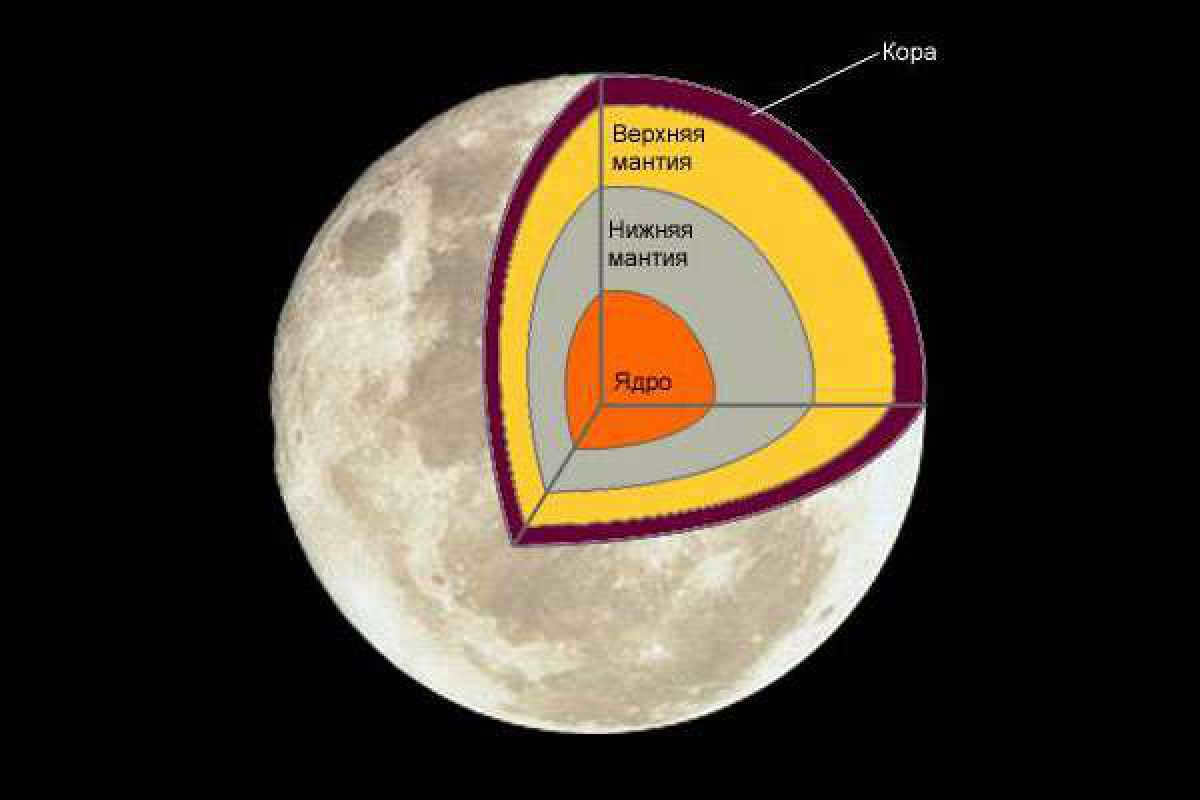

Photo: Internal structure of the Moon
The upper mantle has a thickness of 400 km. Within this layer, seismic velocities vary with depth and decrease as distance increases. The middle mantle is approximately 600 kilometers thick and has constant seismic velocities. The lower mantle is located below 1,100 kilometers. The core of the Moon, which starts at a depth of 1500 km, is likely to be in a liquid state. It contains very little iron, resulting in a weak magnetic field that is only one ten-thousandth of the Earth’s magnetic field. Some local magnetic anomalies have been observed.
There is almost no atmosphere present on the Moon, resulting in drastic fluctuations in temperature. These temperature variations can reach several hundred degrees. During the daytime, the surface can reach a scorching 130°C, while at night it plummets to a bone-chilling -170°C. Interestingly, at a depth of 1 meter, the temperature remains relatively constant. The lack of atmosphere also means that the sky above the Moon is perpetually black, as the presence of air is necessary for the blue color of the sky. Moreover, there is no weather or winds on the Moon, and it is enveloped in complete silence.
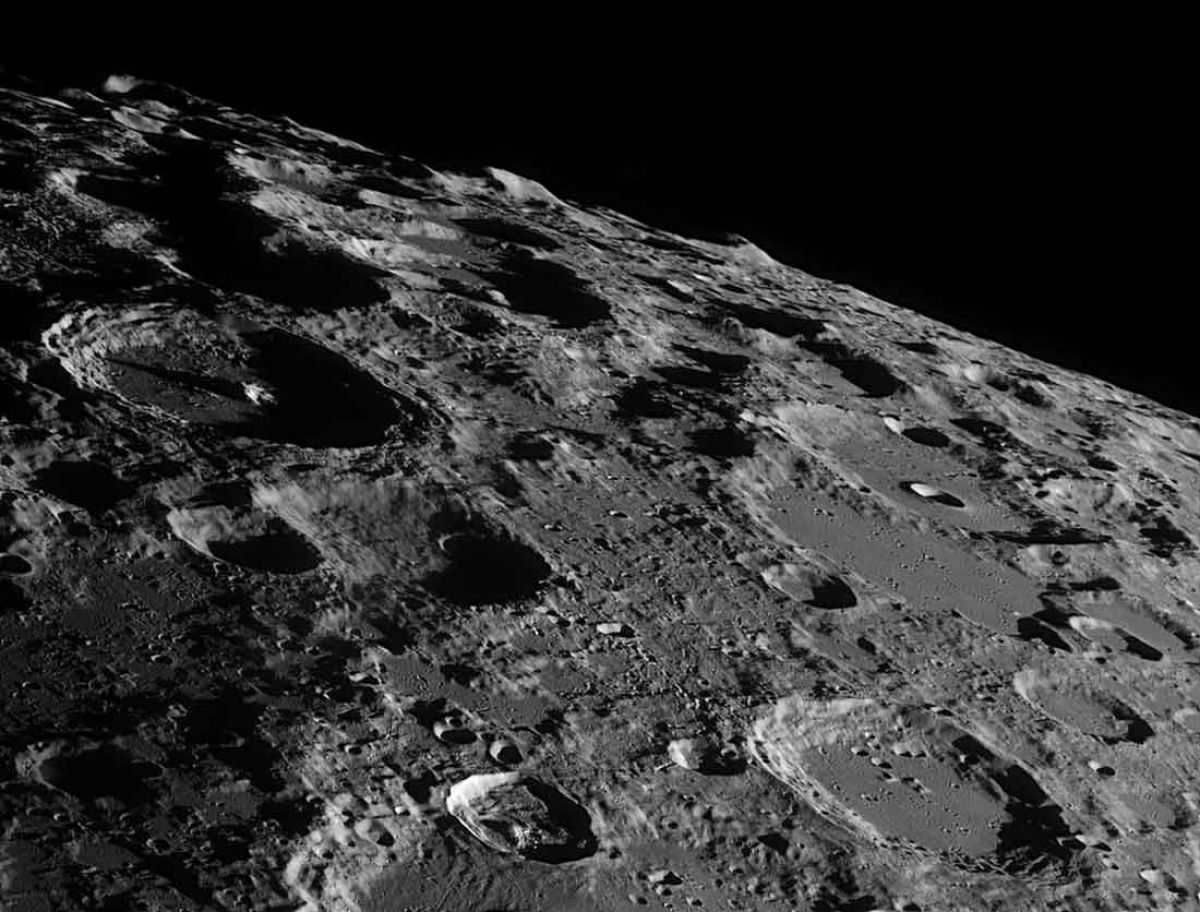
Photo: the Moon’s surface and its atmosphere
Visible section
From Earth, we can only see the visible section of the Moon. However, it is not exactly 50% of the surface, but slightly more. The Moon orbits the Earth in an elliptical path. When the Moon is near perigee, it moves faster, and when it is near apogee, it moves slower. Nevertheless, the Moon rotates uniformly around its axis. As a result, there is a fluctuation in longitude, with a maximum probable value of 7°54. Due to this libration, we have the opportunity to observe not only the visible side of the Moon from Earth, but also narrow strips of territory on its far side that are adjacent to the visible side. In total, we can see 59% of the lunar surface from Earth.
The Moon in ancient times
It has been speculated that in ancient times, the Moon had a faster rotation around its axis, causing different parts of its surface to face the Earth. However, due to the gravitational pull of the massive Earth, powerful tidal waves were generated within the Moon’s solid body. This process of deceleration continued until the Moon ultimately became tidally locked, with only one side permanently facing us.
The Moon, a celestial body that has captivated scientists and the curious throughout history, is an orbiting satellite of our planet. In ancient times, astrologers, astronomers, and poets alike dedicated extensive works to understanding its mysteries. Today, little has changed as astronomers continue to meticulously examine the Moon’s orbit, surface, and interior, while horoscope compilers also take note of its influence. Both astronomers and horoscope compilers study the interactions between the Moon and Earth, observing how these interactions affect movement and other processes. Over time, our understanding of the Moon has greatly expanded.
Source
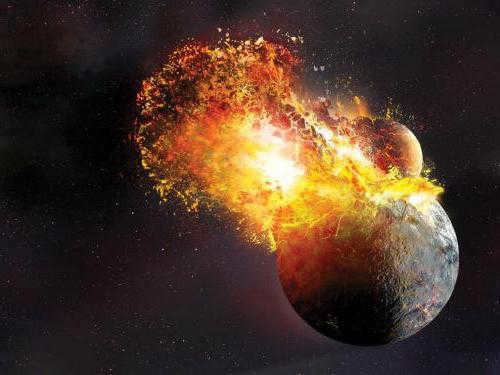
Based on scientific research, it has been determined that the Earth and the Moon were formed at approximately the same time, around 4.5 billion years ago. Various theories have been proposed to explain the origin of the Moon, each offering explanations for certain characteristics, but leaving some questions unanswered. Currently, the theory that is considered to be the most accurate is the giant collision hypothesis.
According to this hypothesis, a planet similar in size to Mars collided with the early Earth. The impact was oblique and resulted in the ejection of most of the matter from this celestial body into space, along with some of the Earth’s own material. The Moon formed from this ejected material. Initially, the Moon’s orbit had a radius of sixty thousand kilometers.
The theory that a massive collision is responsible for the structure and chemical makeup of the moon, as well as many aspects of the Moon-Earth system, is supported by much evidence. However, there are still some unresolved issues when this theory is applied. For example, the lack of iron on the moon can only be explained if both bodies had already undergone internal differentiation by the time of the collision. Currently, there is no concrete evidence to support this idea. Nevertheless, despite these counterarguments, the giant collision hypothesis remains widely accepted as the primary explanation worldwide.
Parameters
Rephrase the text, making it unique, using the English language and preserving the HTML markup:
Parameters
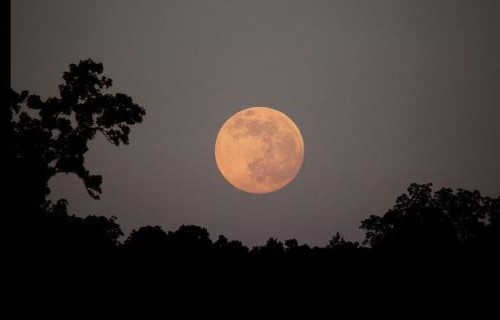
The Moon, similar to most other satellites, lacks an atmosphere. Only small amounts of oxygen, helium, neon, and argon have been discovered. As a result, the surface temperature varies greatly between the sunlit and shaded regions. On the sunny side, it can reach a scorching +120 ºC, while on the dark side, it can plummet to a bone-chilling -160 ºC.
The average separation distance between the Earth and the Moon is approximately 384 thousand kilometers. In terms of its shape, the satellite closely resembles a near-perfect sphere. The disparity between its equatorial and polar radii is minimal, measuring at 1738.14 and 1735.97 km, respectively.
It takes a little over 27 days for the Moon to complete a full revolution around the Earth. The observer can see the Moon go through different phases as it moves across the sky. The time between two full moons is slightly longer, about 29.5 days, because both the Earth and the Moon are also moving around the Sun. To return to its original position, the Moon has to travel a little more than one full circle.
The System of Earth and Moon
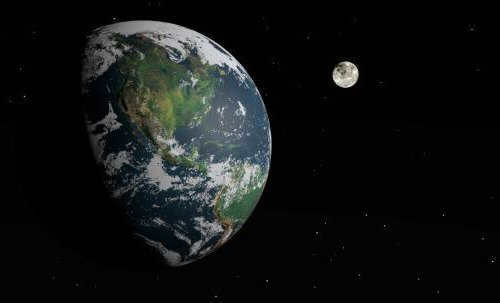
The Moon is a unique satellite with a distinguishing characteristic – its mass. It weighs approximately 7.35*10 22 kg, which is about 1/81 of Earth’s mass. While mass itself is not extraordinary in the vastness of the cosmos, the Moon’s mass-to-planet ratio is atypical. Typically, the mass ratio between satellites and planets is slightly lower. Only Pluto and Charon can boast a similar ratio. These two celestial bodies have recently been referred to as a system of two planets. It seems that this designation holds true for Earth and the Moon as well.
The orbital motion of the Moon
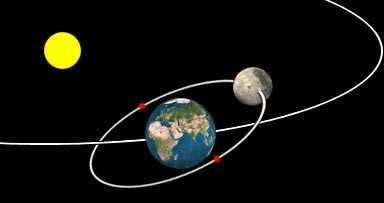
The Moon completes one orbit around the Earth relative to the stars in a sidereal month, which has a duration of 27 days, 7 hours, and 42.2 minutes. The shape of the Moon’s orbit is elliptical, resulting in different distances between the satellite and the planet at different periods. The distance between the Earth and the Moon ranges from 363,104 to 405,696 kilometers.
The Moon’s path around the Earth is influenced by numerous factors. As a result, determining the precise trajectory of the satellite is a challenging task.
A brief history
The explanation of the Moon’s motion was established in 1747. The first calculations, which brought scientists closer to comprehending the peculiarities of the satellite’s orbit, were conducted by the French mathematician Clerot. In the eighteenth century, the Moon’s revolution around the Earth was frequently cited as evidence against Newton’s theory. The calculations made using the law of universal gravitation contradicted the observable movement of the satellite. Clerot successfully resolved this issue.
Famous scientists like Dalembert and Laplace, Euler, Hill, Puizot, and many others dedicated themselves to the investigation of this matter. The exploration of the Moon’s circulation in the modern era truly commenced with the research conducted by Brown in 1923. This British mathematician and astronomer’s groundbreaking work played a pivotal role in resolving the discrepancies observed in calculations and actual observations.
A challenging predicament
The movement of the Moon is comprised of two fundamental processes: rotation around an axis and revolution around our planet. Developing a theory to explain the satellite’s motion would not be overly complicated if its orbit was not affected by various factors. These factors include the gravitational pull of the Sun, the unique shape of the Earth, and the gravitational fields of other celestial bodies. These influences disrupt the orbit and make it challenging to accurately predict the Moon’s exact position at any given period. To gain a better understanding of this matter, let us examine some parameters of the satellite’s orbit.
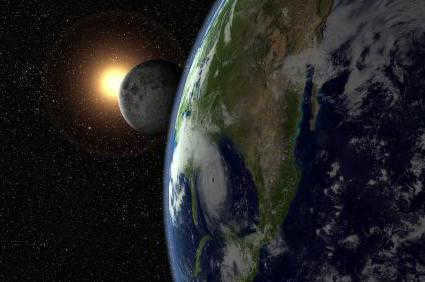
Orbit Nodes and Apsidal Line
As mentioned before, the Moon’s path around the Earth is tilted relative to the ecliptic. The paths of the two celestial bodies intersect at specific points known as the orbit nodes, which are located on opposite sides of the Moon’s orbit in relation to the Earth’s center. The line that connects these nodes is referred to as the line of nodes.
The point where the Moon is closest to the Earth is called perigee, while the farthest point is known as apogee. The line connecting these two points is called the apsidal line.
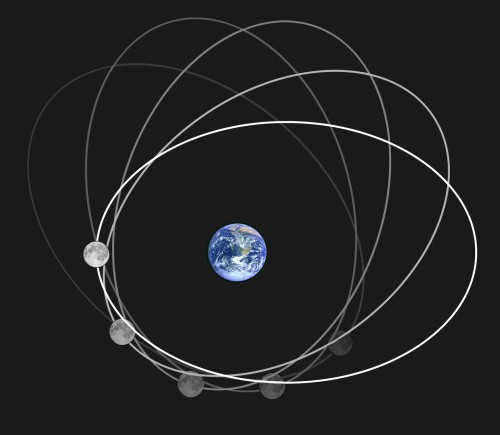
Due to the influence of numerous factors on the motion of the satellite, it can be considered as a combination of various motions. Let’s examine the most significant perturbations that result from this.
One of these perturbations is the retrograde motion of the line of nodes. The line that connects the two points where the plane of the Moon’s orbit intersects with the ecliptic is not stationary. It slowly moves in the opposite direction (hence referred to as retrograde) to the satellite’s motion. Essentially, the plane of the Moon’s orbit rotates in space. It takes 18.6 years to complete a full revolution.
The apsidal line is also in motion. The movement of the line that connects the apocenter and pericenter is expressed by the rotation of the orbital plane in the same direction as the Moon’s movement. This rotation occurs at a much faster rate compared to the line of nodes. A complete revolution of the apsidal line takes 8.9 years.
Furthermore, the lunar orbit undergoes oscillations of a certain amplitude. The angle between the plane of the lunar orbit and the ecliptic changes over time. This angle ranges from 4°59' to 5°17'. Similar to the line of nodes, these fluctuations occur over a period of 18.6 years.
Lastly, the shape of the Moon’s orbit undergoes changes. It elongates slightly and then returns to its original configuration. The eccentricity of the orbit, which measures the extent to which its shape deviates from a perfect circle, changes from 0.04 to 0.07. It takes 8.9 years for this change to occur and for the orbit to return to its original position.
It’s not as easy as it seems
Basically, there are only a few factors that need to be considered during the calculations. However, these factors do not cover all the disturbances in the satellite’s orbit. In reality, each parameter of the Moon’s motion is constantly influenced by numerous factors. This adds complexity to the task of accurately predicting the satellite’s exact location. Taking all of these parameters into consideration is often the most crucial aspect. For instance, the calculation of the Moon’s trajectory and its precision has an impact on the success of a spacecraft mission sent to it.
The Influence of the Moon on Earth
The Earth’s satellite may be relatively small in size, but its impact on our planet is undeniably significant. It is widely known that the Moon is responsible for the creation of tides on Earth. However, it is important to note that the Sun also plays a role in this phenomenon. Due to its much greater distance from Earth, the tidal effect caused by the Sun is not as noticeable. Furthermore, the fluctuation in water levels in the seas and oceans is also influenced by the Earth’s own rotation.
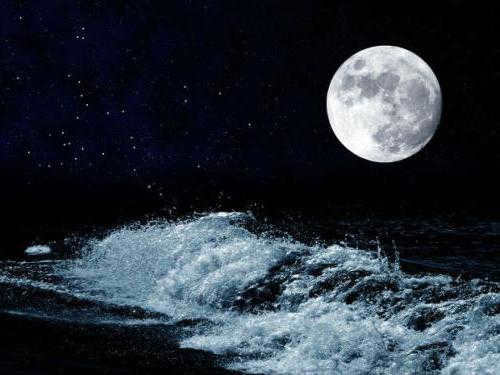
The gravitational pull of the Sun on Earth is approximately two hundred times stronger than that of the Moon. However, tidal forces are mainly influenced by the variations in the gravitational field. The distance between Earth and the Sun helps to even out these forces, making the Moon’s gravitational impact more pronounced when it is closer to us (twice as powerful as that of the Sun).
A tidal surge emerges on the region of the planet that is presently facing the nighttime sky. A tide also materializes on the opposing side. If the Earth remained stationary, the tide would progress from the west to the east, precisely beneath the Moon. Its full rotation would be accomplished in roughly 27 days, or in what is known as a sideric month. However, the Earth’s rotational period around its axis is slightly less than 24 hours. Consequently, the surge traverses the planet’s surface from east to west and completes one full rotation in 24 hours and 48 minutes. As the surge consistently encounters landmasses, it advances forward in the direction of the Earth’s motion and surpasses the planet’s satellite in its journey.
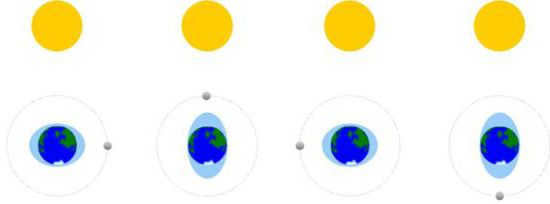
Changing the Moon’s Orbit
The movement of the tidal wave results in the displacement of a large mass of water. This directly impacts the orbital motion of the moon. A significant portion of the Earth’s mass shifts away from the line connecting the centers of mass of the two celestial bodies, thereby attracting the moon towards it. Consequently, the moon experiences a torque that accelerates its orbital velocity.
Simultaneously, the continents that encounter the tidal wave (as they move at a faster speed than the wave due to the Earth’s higher rotation rate compared to the moon) experience a decelerating force. This gradual deceleration leads to a slowdown in the rotation of our planet.
Due to the interaction of tides between the Earth and the Moon and the principles of energy and momentum conservation, the satellite gradually transitions to a higher orbit, while the Moon’s velocity decreases, causing it to orbit at a slower pace. A similar effect occurs on Earth, resulting in a gradual lengthening of the day.
The Moon is steadily moving away from the Earth at a rate of approximately 38 mm per year. Studies conducted by paleontologists and geologists validate the calculations made by astronomers. This process of Earth’s gradual deceleration and the Moon’s retreat began around 4.5 billion years ago, coinciding with the formation of these celestial bodies. The findings of researchers support the hypothesis that the lunar month was shorter in the past, and that Earth rotated at a higher speed.
The Moon will not be removed and the Earth’s rotation will not slow down indefinitely. Eventually, the Earth’s rotation period will match that of the Moon, causing the Moon to remain fixed over one area of the Earth’s surface. This means that the Earth and the Moon will always have the same side facing each other. It is important to note that this process has already occurred to some extent, as tidal interaction has caused the Moon to always show the same side to Earth. A similar equilibrium can be observed in the cosmos with the system of Pluto and its moon Charon.
The Moon and the Earth have a continuous and intricate relationship. Determining which entity has a greater influence on the other is a complex task. Additionally, both celestial bodies experience the gravitational pull of the Sun. Furthermore, there are other celestial bodies that are more distant but still exert a significant impact. Taking all of these factors into consideration, accurately constructing and describing the model of satellite motion in orbit around our planet becomes quite challenging. However, thanks to the vast amount of accumulated knowledge and the constant improvement of equipment, we are able to predict the position of satellites with a reasonable degree of accuracy and anticipate the future for each individual object and the Earth-Moon system as a whole.
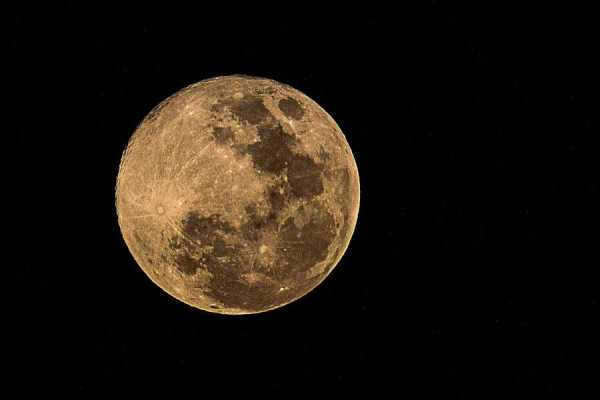
At first glance, the Moon appears to simply orbit the planet Earth at a specific speed and in a specific orbit.
Factors that cause the Moon to rotate
In reality, the motion of the Moon is a highly complex process that is difficult to scientifically describe. It is influenced by a multitude of factors, such as the shape of the Earth (which, as we learned in school, is slightly flattened), as well as the significant gravitational pull of the Sun, which is 2.2 times stronger than that of our home planet.
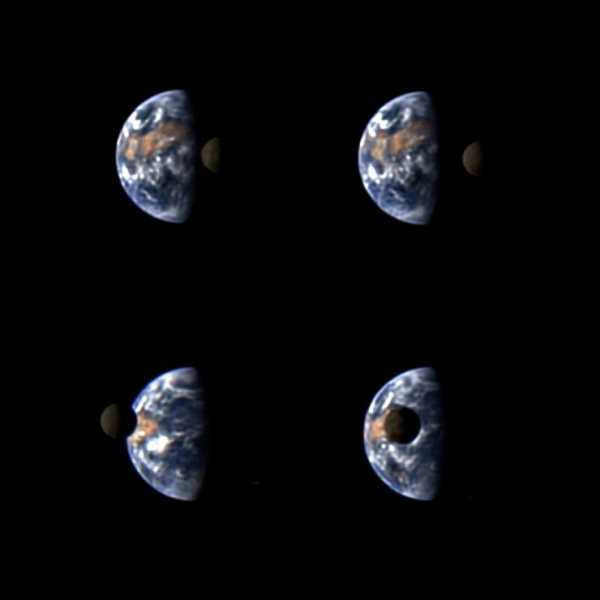
Images of the Deep Impact spacecraft capture the Moon’s rotational movement around the Earth.
When calculating the Moon’s movement, it is important to consider the tidal interaction between the Earth and the Moon. The Earth transfers its rotational momentum to the Moon, causing it to move away. However, this gravitational interaction is not constant and decreases as the distance between the two bodies increases. As a result, the rate at which the Moon moves away from the Earth decreases. The Moon’s rotation around the Earth in relation to the stars is known as the sideric month, which lasts approximately 27.32166 days.
Mars Express captured an incredible image of the Earth and the Moon, showcasing their beauty and unique relationship.
Have you ever pondered the reasons behind the Moon’s partial visibility and its mysterious glow? Let’s delve into the fascinating science behind it! The Moon reflects a mere 7% of the sunlight it receives, resulting in its subtle illumination. This phenomenon occurs due to the Moon’s surface selectively absorbing and storing solar energy during periods of intense solar activity, subsequently emitting it in a subdued manner.
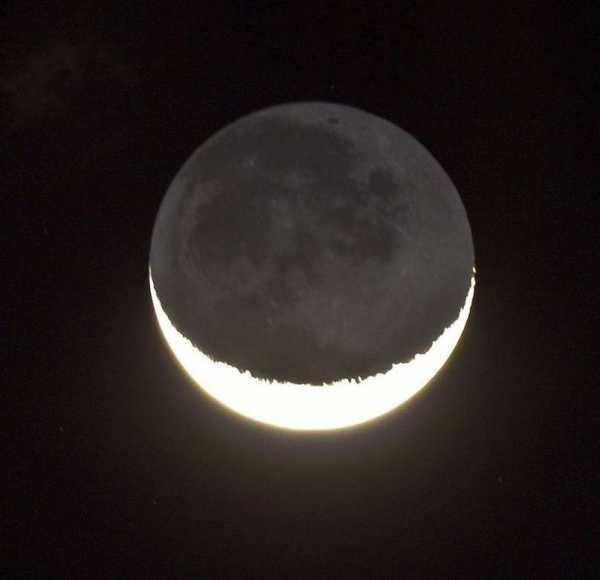
The Moon reflects ash light, which is the light that is reflected from the Earth. It does not emit its own light, but rather reflects the light of the Sun. As a result, we can only see the parts of the Moon that are illuminated by the Sun. The Moon orbits around our planet in a specific path, and the angle between the Moon, the Sun, and the Earth constantly changes. This is why we observe different phases of the Moon.
Moon Phases visual representation
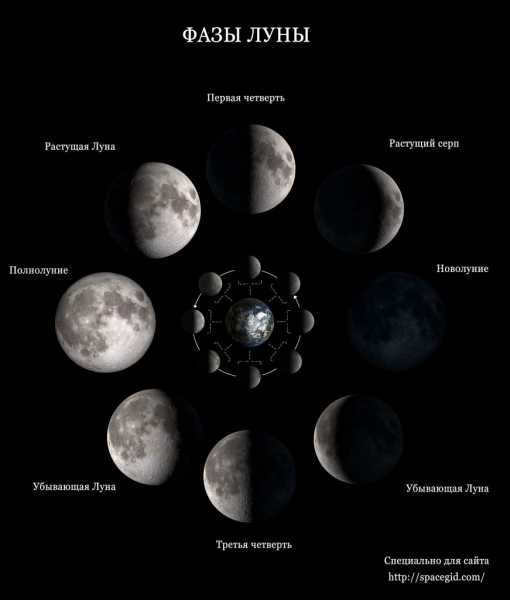
The time it takes for the moon to complete one orbit around the Earth is approximately 28.5 days. This difference in duration can be attributed to the Earth’s motion around the Sun. As the moon completes a full revolution around the Earth, the Earth itself moves about 1/13th of its orbit. This slight shift in position causes the moon to require an additional two days to align between the Sun and the Earth once again.
Although the moon rotates on its axis, it always presents the same face to the Earth. This synchronous rotation is influenced by the gravitational forces of the tides.
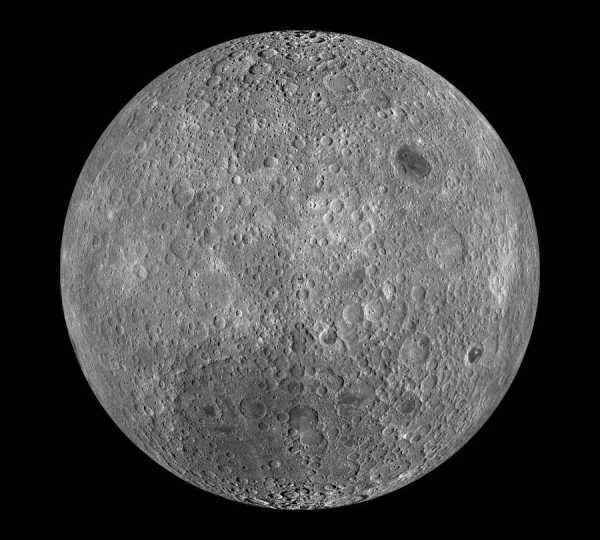
Our satellite revolves in a uniform manner on its own axis and follows a specific law as it orbits around the Earth. The essence of this law is as follows: the satellite’s movement is not constant – it is faster near perigee, but slightly slower near apogee.
On certain occasions, it is possible to observe the far side of the Moon when located in the east or west. This phenomenon is known as optical longitude libration, and there is also optical latitude libration. The latter is caused by the tilt of the lunar axis in relation to the Earth, and can be observed in the north and south.
Our planet’s natural satellite, THE MOON, is always close to us. It is a rocky sphere with no atmosphere or signs of life. The Moon has a diameter of 3480 km, which is slightly more than a quarter of the Earth’s diameter. When we look at the Moon from Earth, its visible disk has an angular diameter of about 30 degrees. The average distance between the Moon and Earth is 384,400 km, which is equivalent to about 30 times the diameter of Earth. It takes less than 3 days for a spacecraft to reach the Moon. The first spacecraft to successfully land on the Moon was Luna-2, launched by the USSR on September 12, 1959. It wasn’t until July 20, 1969, that humans, specifically the Apollo 11 astronauts from the United States, set foot on the Moon.
Even prior to the age of space exploration, astronomers had knowledge that the Moon was a peculiar celestial body. While it may not be the largest satellite within the solar system, it does have one of the largest sizes when compared to its planetary counterpart, Earth. The Moon’s density is merely 3.3 times that of water, which is lower than the density of any of the planets in the Earth group: Earth itself, Mercury, Venus, and Mars. These circumstances alone prompt us to consider the exceptional conditions under which the Moon was formed. Soil samples collected from the Moon’s surface have provided insights into its chemical composition and age (the oldest samples indicate an age of 4.1 billion years), yet these findings have only further muddled our understanding of the Moon’s origin.
OUTDOOR PERSPECTIVE
Similar to other celestial bodies, such as planets and their moons, the Moon primarily emits a glow by reflecting sunlight. Normally, the portion of the Moon that is illuminated by the Sun is observable. However, during the new moon phase, the Earth’s faint reflection of light delicately illuminates the Moon’s shadowed side, depicting an image of the “elderly Moon cradled by the youthful”.
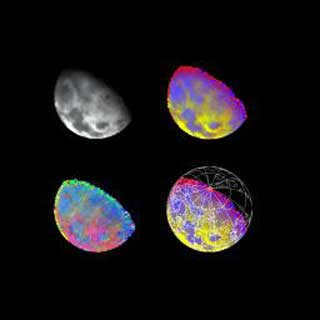
The Moon rotates around the Earth at a speed significantly slower than the Sun. The Sun’s brightness is 650 thousand times greater than that of the full Moon. When the Sun’s light falls on the Moon, only 7% of it is reflected back. Sometimes, after periods of intense solar activity, certain areas of the lunar surface may emit a faint glow, which is caused by luminescence.
On the observable face of the Moon – the one that is always facing the Earth – are prominent dark regions known as seas (from the Latin word “mare”) according to past astronomers. Due to their relatively flat terrain, the seas were selected as landing sites for the initial astronaut missions; research has revealed that the seas consist of a dry surface covered with small, porous fragments of lava and occasional rocks. These expansive, dark regions of the Moon starkly contrast with the bright, mountainous areas, which have a rough surface that reflects light more effectively. Spacecraft that have orbited the Moon have discovered, contrary to expectations, that the far side of the Moon lacks large seas and therefore does not resemble the observable side.
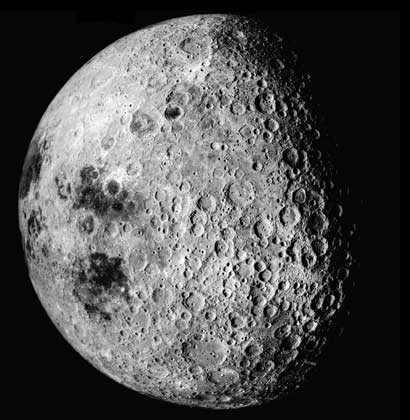
The Illusion of the Moon.
When the Moon is near the horizon, it appears to be much larger than when it is high up in the sky. This phenomenon is actually an optical illusion. Various psychological experiments have been conducted to demonstrate that our perception of an object’s size is influenced by the size of other objects in our field of view. For example, when the Moon is high in the sky and surrounded by a vast expanse of empty space, it appears smaller. However, when it is close to the horizon, we are able to compare its size with the distance between it and the horizon, leading us to perceive it as larger. This comparison unconsciously enhances our impression of the Moon’s size.
Lunar Phases
The different stages of the Moon’s appearance are a result of the changing positions of the Earth, Moon, and Sun relative to each other. For instance, when the Moon is positioned between the Earth and the Sun, the side that faces the Earth is in darkness and appears almost invisible. This particular moment is known as the new moon, as it marks the start of the Moon’s cycle and its gradual increase in visibility. After completing a quarter of its orbit, the Moon displays half of its illuminated surface, referred to as the first quarter. Once the Moon reaches the midpoint of its orbit, the entire Earth-facing side becomes visible, marking the phase known as the Full Moon.
When viewed from the Moon, the Earth experiences various phases. For instance, during a new moon, the Moon appears completely dark to an observer on Earth, but an astronaut on the Moon perceives a fully illuminated “full Earth”. Conversely, when Earth witnesses a full moon, the Moon displays a “new moon” phase when observed from the Moon. In the first and third quarters, when people on Earth witness half of the lunar disk illuminated, astronauts on the Moon also observe half of the Earth’s disk illuminated.
MOTION
The primary factor affecting the movement of the Moon is the Earth, although it is also influenced by the Sun, which is much farther away. Understanding the motion of the Moon is considered one of the most challenging issues in celestial mechanics. Isaac Newton put forth the first credible explanation in his renowned work, Elements (1687), where he introduced the law of universal gravitation and the laws of motion. Newton not only accounted for all the known deviations in the lunar orbit at that time, but also made predictions about some future effects.
The time it takes for the Moon to complete a full orbit around the Earth at 360 degrees is 27 days 7 hours 43.2 minutes. However, during this time, the Earth also moves around the Sun in the same direction, causing the positions of the three bodies to repeat about 53 hours after the Moon’s orbital period. As a result, a full moon occurs every 29 days 12 hours 44.1 minutes, which is known as a lunar month. Each solar year consists of 12.37 lunar months, meaning that 7 out of 19 years have 13 full moons. This 19-year period is referred to as the “metonic cycle” because the Athenian astronomer Meton proposed it in the 5th century BC as the basis for a calendar reform that ultimately did not occur.
The distance to the Moon undergoes constant fluctuations, a fact that has been known since the 2nd century BC by Hipparchus. He was able to determine the average distance to the Moon, a value that closely aligns with the modern measurement – equivalent to 30 Earth diameters. The distance to the Moon can be calculated using various methods, such as triangulation from two distant locations on Earth or through the utilization of modern technology, such as radar or laser signals. The average distance at perigee, which is the point of the Moon’s orbit closest to Earth, measures at 362,000 km. On the other hand, the average distance at apogee, the farthest point of the orbit, is approximately 405,000 km. These measurements are taken from the Earth’s center to the Moon’s center. The apogee point, along with the entire orbit, completes one revolution around the Earth in a span of 8 years and 310 days.
Slant.
The Moon’s orbit is tilted at an angle of about 5° to the Earth’s orbit around the Sun, known as the ecliptic. As a result, the Moon never strays more than 5° from the ecliptic, always remaining close to the zodiacal constellations. The points where the Moon’s orbit intersects the ecliptic are called nodes. A solar eclipse can only occur during a new moon when the Moon is near a node. This happens at least twice a year. At other times, the Moon passes above or below the Sun in the sky. Lunar eclipses, on the other hand, only occur during a full moon when the Moon is near a node. If the Moon’s orbit were not inclined to the Earth’s orbit, meaning they both moved in the same plane, there would be a solar eclipse every new moon and a lunar eclipse every full moon. The line connecting the nodes, which is a straight line, rotates around the Earth in the opposite direction of the Moon’s motion, with a period of 18 years and 224 days. This period is closely related to the saros cycle, which is 18 years and 11.3 days, and defines the time between identical eclipses.
See also ECLIPSES.
System of Earth and Moon.
Naturally, it is not entirely accurate to refer to the movement of the Moon around the Earth. Specifically, both of these celestial bodies orbit around a shared center of mass located beneath the Earth’s surface. Examination of the Earth’s vibrations indicated that the mass of the Moon is 81 times smaller than that of the Earth.
The gravitational force exerted by the Moon leads to the occurrence of tides on the Earth. These tidal movements, resulting from the friction between the Earth and the Moon, have the effect of decelerating the Earth’s rotation, gradually lengthening the duration of a day on Earth by 0.001 seconds per century. As a consequence of the conservation of momentum in the Earth-Moon system, the deceleration of the Earth’s rotation causes the Moon to gradually move away from the Earth. Nevertheless, in the current epoch, the distance between the Earth and the Moon is actually decreasing at a rate of 2.5 centimeters per year, owing to the intricate interplay of the Sun and the planets with the Earth.
For further information, you may refer to TIDES.
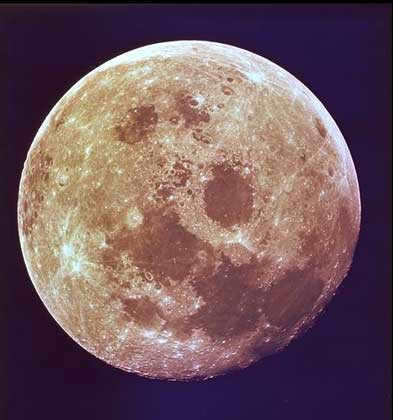
Gravity measurements conducted by the U.S. Lunar Orbiter in circumlunar orbit have provided partial validation of the non-uniformity of the Moon’s internal composition: certain expansive lunar maria have revealed the presence of mascons, which are regions of heightened matter density formed by the aggregation of dense rock amidst comparatively lighter rocks.
SURFACE SPECIFICS
While the Moon consistently faces one side of the Earth, we have the opportunity to observe slightly more than half of its surface. When the Moon reaches the highest point of its inclined orbit, we are able to view an usually concealed region near its southern pole, and the area around the northern pole becomes visible when the Moon reaches the lowest point of its orbit. Furthermore, additional regions on the eastern and western edges of the Moon can be observed as it rotates on its axis at a constant velocity and as its speed around the Earth varies from maximum at perigee to minimum at apogee. Consequently, there are fluctuations – libration – of the Moon that enable 59% of its surface to be observed. Areas that are completely unobservable from Earth are captured in photographs by spacecraft.
The first comprehensive map of the visible side of the Moon can be found in J. Hevelius’s Selenography, or description of the Moon (1647). In 1651, G. Riccioli proposed naming the features on the lunar surface after notable astronomers and philosophers. The modern study of the physical properties of the Moon, known as selenography, was initiated with the publication of a detailed and meticulously described map of the Moon in 1837 by W. Bera and I. Mödler.
The photography of the Moon commenced in 1837 and reached its pinnacle in the Systematic photographic atlas of the Moon (J. Kuiper et al., 1960). It showcases regions of the Moon that are illuminated by sunlight from at least four different perspectives. The finest level of detail in the photographs captured from the Earth’s surface is 0.24 km. The five Lunar Orbiter spacecraft, which were successfully launched in 1966 and 1967, acquired an exceptional and almost comprehensive photographic map of the Moon from a near-lunar orbit. As a result, even the intricate features on the Moon’s far side are now known with a resolution that is ten times superior to the details of its visible side in 1960. Elaborate maps of the Moon have been generated at NASA and can be obtained from the U.S. Government Documents Office.
There are three primary categories of formations that can be identified on the Moon: 1) oceans – expansive, dark, and relatively level regions of the surface coated with basaltic lava; 2) landmasses – illuminated elevated regions filled with numerous sizable and small circular craters, frequently overlapping; 3) ranges of mountains, such as the Apennines, and minor mountain systems like the one encircling the Copernicus crater.
Oceans.
The Sea of Rains, which measures approximately 1200 km in diameter, is the largest among the twelve seas located on the visible side of the Moon. It is believed that this particular sea was formed as a result of a massive collision between a meteorite or comet nucleus and the Moon. The presence of distinct peaks and a chain of mountains with radial rays surrounding the Sea of Rains provide further evidence of this impact event. Although the bottom of the Sea of Rains is not completely flat, it is covered in ripples that can be observed when sunlight hits the surface at a low angle. These ripples, along with the variation in color, suggest that multiple lava spills occurred here, possibly as a result of several successive impacts.
Photographs taken from a close orbit around the moon have uncovered a basin that is even more impressive than the Sea of Rains. This particular basin is called the Sea of the East, and although it is partially visible from Earth on the left side of the moon, its true appearance is only revealed through images captured by the Lunar Orbiter. The central dark plain of the Sea of the East may be relatively small in size, but it is surrounded by a vast number of circular and radial mountain ranges. These mountain ranges form two nearly perfect concentric chains, with diameters of 600 and 1000 kilometers respectively. Beyond the outer chain of mountains, there are complex radial formations of rocks that stretch for over 1000 kilometers.
The Sea of Clarity’s nearly circular shape suggests a smaller-scale collision, resulting in its current contour. It appears that other seas were also formed through similar collisions, with subsequent collisions destroying the original crater.
Some large cratered areas that were not destroyed by powerful collisions may have transformed into seas due to extensive lava flows. The Ocean of Storms and the Sea of Tranquility are examples of such areas, characterized by their irregular shapes and partially submerged ancient craters. Each sea exhibits unique color variations, with the central region of the Sea of Clarity displaying a reddish hue indicative of older, deeper layers, while the outer part of this sea and the neighboring Sea of Tranquility have a bluish tint.
The characteristics of the Moon’s surface.
A significant discovery made during the Apollo program was the identification of the Moon’s robust crust. In the vicinity of the Fra Mauro crater, where the Apollo 14 mission landed, the crust measures approximately 65 kilometers in thickness. The Moon’s surface is predominantly covered by a layer of loose debris known as regolith, which varies in depth from 3 to 15 meters. Consequently, solid bedrock is scarce, with only a few recently formed large craters exposing it. The regolith primarily consists of small particles of varying sizes, typically around 25 µm. It is a composite material comprising rock fragments, microscopic spheres known as spherules, and fragments of glass. The regolith exhibits high porosity and compressibility, yet it possesses sufficient strength to bear the weight of an astronaut.
The rock samples obtained from the Apollo 11, -12, and -15 missions have been identified as predominantly basaltic lava. This particular type of marine basalt is known for its high iron content and, to a lesser extent, titanium. It is worth noting that while oxygen is unquestionably a fundamental element in lunar rock formations, the lunar rocks contain significantly less oxygen compared to their terrestrial counterparts. Furthermore, it is important to emphasize the complete absence of water, even within the crystal structure of minerals. The basaltic rocks collected during the Apollo 11 mission have the following chemical composition:
| Table | The Apollo 11 mission delivered rock samples |
| Component | Content, % |
| Silicon dioxide (SiO2) | 40 |
| Iron oxide (FeO) | 19 |
| Titanium dioxide (TiO2) | 11 |
| Aluminum oxide (Al2O3) | 10 |
| Calcium oxide (CaO) | 10 |
| Magnesium oxide (MgO) | 8.5 |
The samples obtained during the Apollo 14 mission are an example of a different kind of crust known as breccia, which contains a high concentration of radioactive elements. Breccia is formed when fragments of rock are fused together by small particles of regolith. Another type of lunar crust sample is anorthosite, which is rich in aluminum. This type of rock is lighter in color compared to the dark basalts and has a similar chemical composition to the rocks analyzed by Servaeor-7 near Tycho Crater. Anorthosite is less dense than basalt, giving the appearance that the mountains composed of it are floating on the denser lava.
All three rock types are present in the large samples collected by the Apollo astronauts. However, the confidence in identifying them as the major components of the lunar crust is based on the analysis and classification of countless small fragments from soil samples gathered from various locations on the lunar surface.
Craters
– is one of the distinctive characteristics of the Moon. A medium-sized telescope can reveal tens of thousands of craters. The largest of these craters appear as flat pads surrounded by walls. Notable examples include Grimaldi, Schickard, and Tsiolkovsky (located on the far side of the Moon), which have a diameter of approximately 250 km and feature smooth lava bottoms. Various missions, such as the Rangers, Surveyors, and Apollo missions, have also uncovered numerous small craters, some as small as tiny potholes. While most craters have a rounded shape, the largest ones exhibit polygonal forms. When viewed from Earth, the stark contrast between light and shadow creates the illusion of a highly uneven lunar surface; however, the walls of these craters are actually quite gradual.
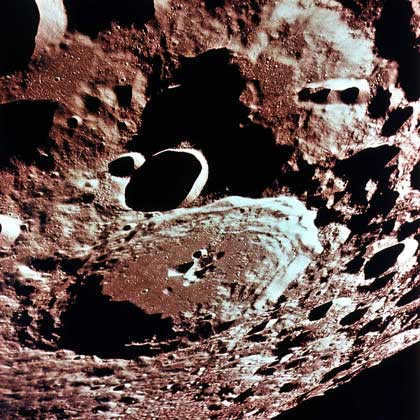
Most of the craters on the Moon were created when meteorites and comet nuclei collided with its surface during its early history. The larger craters, known as primary craters, were formed directly by the impact of these celestial bodies, while the smaller craters, called secondary craters, were created by the debris ejected from the primary explosions. These secondary craters tend to be found near primary craters and often appear in pairs or have an elongated shape. Impact craters on Earth bear a striking resemblance to lunar craters. However, terrestrial craters are gradually eroded over time by the effects of wind, rain, and other environmental factors, whereas on the Moon, which lacks an atmosphere, these ancient formations remain relatively unchanged.
There is a possibility that certain craters have formed due to volcanic activity. These particular craters have a distinctive shape, resembling funnel-shaped pits, and display bright white walls when the Moon is in its full phase. The presence of these craters being arranged in rows, possibly along seismic cracks or on mountain peaks, further supports the theory put forward by J. Kuiper, a Dutch-born American astronomer, that they are of volcanic origin. Additionally, infrared observations conducted during total lunar eclipses have detected numerous areas of elevated temperature, which tend to coincide with newly formed and visually striking craters.
Given that most craters are located in light-colored continental regions, it can be inferred that they are older than the seas. According to Kuiper’s findings, the first craters were formed after the seas had acquired a smooth lava floor. Subsequently, the surface underwent melting, although not enough to completely fill the craters with lava, as evidenced by visible volcanic outpourings. During the full moon, certain craters such as Tycho, Copernicus, and Kepler become strikingly white, emitting long white streaks known as “rays” that diverge radially from them. These craters possess irregular central slides and contain a significant amount of small debris within their ramparts. Since the rays overlay other lunar formations, it can be concluded that the ray craters are the most recently formed craters on the Moon. The findings from the “Ranger 7” mission revealed that the rays are comprised of rows of numerous white secondary craters.
There is much controversy surrounding the observations of alterations in the lunar surface. These alterations are typically visible changes caused by variations in the angle at which the sun’s rays hit the surface. For a long time, astronomers have debated whether Linnaeus, a bright spot located in the Sea of Clarity, was once a crater, as indicated on an old lunar map found in Riccioli’s work. In 1958, Soviet astronomer N.A. Kozyrev made an observation of what was likely a gas eruption in the Alfons crater. Initially met with skepticism, this finding sparked interest among astronomers in the possibility of active volcanic activity on the Moon. Analyzing scattered observations reveals that regions of potential activity are concentrated along the perimeters of the lunar seas.
Additional characteristics.
Mountain ranges, a common sight on Earth, are relatively rare on the Moon. The Apennines, the Alps, and the Caucasus are the main mountain ranges on the visible side of the Moon, and they were likely formed by the collision that created the Sea of Rains. Other seas on the Moon also have concentric mountain ranges surrounding them. Some mountains along the southern edge of the Moon are similar in height to Mount Everest. Wrinkles caused by compression can be seen in most seas, and they often have a stepped structure with parallel but slightly shifted segments. In some cases, these wrinkles resemble a complex braid.
A huge network is created by wrinkles, fissures, wide and narrow valleys. The largest reticulated system on the Moon is formed by the radial relief patterns associated with the Sea of Rains. Certain scientists suggest that the reticular system indicates stress and compression processes within the Moon, while others believe it is a consequence of external influences caused by the collisions that resulted in the formation of the seas.
Many other characteristics have been uncovered on the lunar surface. The most impressive geological feature is the Straight Wall, which stretches approximately 170 km into the Sea of Clouds; it forms a steep cliff that reaches a height of about 300 m. The Reith Valley serves as an illustration of a graben, a fault zone where a significant portion of the surface has started to sink. Various small dormant volcanoes have been discovered on the seafloor. Additionally, the lunar landscape is adorned with small lava domes, which are another intriguing aspect of the Moon’s surface.
Refer to. also: LUNAR ORIGIN AND HISTORY; SPACE EXPLORATION AND UTILIZATION; TIDES.
The Earth’s natural satellite, known as the moon, plays a crucial role in the existence of life on our planet. Without it, our world would be drastically different. With a diameter of 3474 km and an orbital period of 27.3 days, the moon orbits around the Earth. However, it also experiences the gravitational pull from the Earth, causing it to move in a small orbit around the center of mass, which is approximately 1700 km from the Earth’s surface.
Despite its importance, the moon has a relatively small mass, only 0.1 of that of the Earth. It maintains an average distance of about 380,000 km from our planet. Additionally, the moon’s orbital velocity is 1 km/sec, and it always faces the Earth on one side. The temperatures on the moon vary greatly, with daytime temperatures reaching as high as +120°C and nighttime temperatures dropping as low as -160°C.
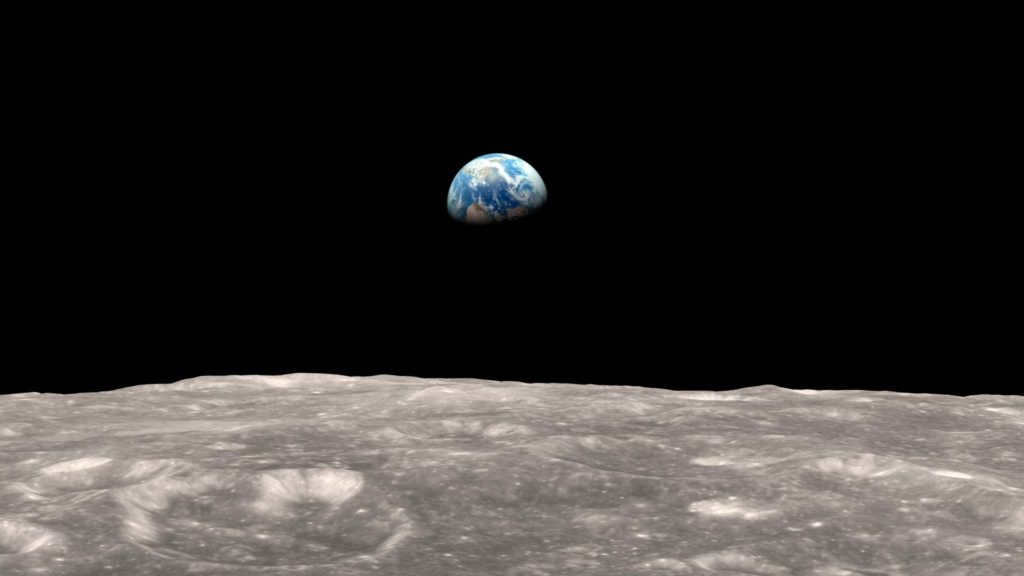
There are two types of lunar surface: one is mountainous and old, with numerous volcanoes, while the other is younger and flat, with smooth lunar seas. The lunar seas are actually craters that were formed due to collisions with large celestial objects, and later filled with lava.
According to the theory known as the Giant Impact theory, the Moon was formed when a planetary body collided with the Earth, causing a certain amount of matter to be released.
- The Earth’s satellite, the Moon, is gradually moving away from our planet at a rate of 4 cm per year.
- It is a fascinating coincidence that the Moon and the Sun appear to be the same size in the sky. This is because the Moon is 400 times smaller than the Sun, but it is also conveniently positioned about 400 times farther away from us.
- Interestingly, only 7% of the sunlight that reaches the Moon is reflected back into space from its surface.
The Impact of the Moon
The Moon has a profound impact on both the Earth and its inhabitants. One of the most significant and influential effects is the creation of tides. By exerting its gravitational force, the Earth’s satellite causes the ocean waters to rise and fall, resulting in the ebb and flow of tides along the shores. On the opposite side of the planet, the water in the oceans is pushed inward, leading to the occurrence of tides.
Furthermore, the Moon’s 28-day cycle is closely intertwined with human biorhythms. The gravitational pull of the satellite affects the functioning of organs and the circulatory system. Additionally, the human psyche is also susceptible to the influence of this celestial body. It is worth noting that the intensity of the Moon’s impact varies depending on its different phases.





